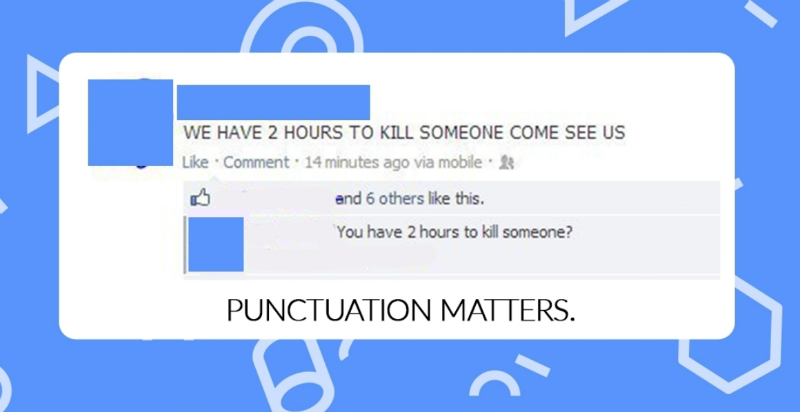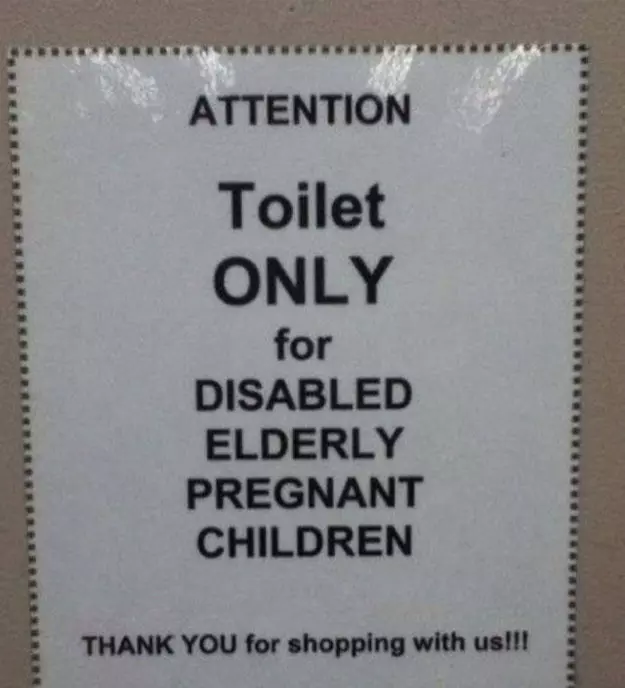How to use commas in English: 15 rules and error examples
- Transfer

Punctuation is very important if you want to convey your thoughts clearly and get the expected response. However, in English, punctuation is very different from what we are used to in Russian. Moreover, it differs in various varieties of English.
In general, there are many difficult moments here, which can be difficult to deal with on your own. I found an interesting post with rules for using commas in English and examples of errors. I present to you his adapted translation.
Rule # 1. A comma is placed before the coordinating union, which combines the two sentences.
A group of words that can act as a separate sentence is called independent clause. If you have two such objects that you want to combine in one more complex sentence using the unions and, but, or, so and others, it is important to put a comma in front of such an alliance.
I went to the mall to score new boots, but I failed to find my size.
In the example above, both parts of a sentence can be separate sentences, but are combined into one union but. And if so, then a comma is needed in front of him.
Rule # 2. Commas are needed for enumerations.
If your proposal is listing any elements, then they must be separated by commas.
John was obsessed with parties, girls, and sports cars.
At the same time, there are also subtleties. For example, the use of the so-called Oxford comma (comma before and). To put it or not depends on what dialect and style of English you use. For example, Oxford comma is used in American English. At the same time, there is an AP Style writing style guide, which was created for journalists and newspaper reporters, and does not imply the use of Oxford comma.
Here's what happens if you don’t separate items in the list with commas.

Source: Reddit
Rule # 3. Comma separates dependent and independent sentences
If your proposal consists of two, and one of them depends on the other and follows after it, then you do not need to put a comma. But if such a dependent sentence is at the beginning, then you need to put a comma after it.
Examples:
You should read more if you're going to become a journalist. (The dependent part comes after the one on which it depends, so no comma is needed)
If you're going to become a journalist, you should read more. (The sentence starts with the dependent part, so it’s the right place to put a comma).
Rule # 4. Commas are placed after opening words and word groups.
Sometimes at the beginning of a sentence there are separate introductory words (for example, however) or whole groups of words (on the other hand). The reasons for their use may be different, usually this allows you to prepare the reader for the main part of the sentence. The rule states that such introductory words and groups of words must be marked with a comma.
Finally, I had enough money to buy this car.
Tip : Adverbs are usually introductory words, many of which end with -ly. So if the first word in the sentence is the word -ly, you will need to put a comma after it.
Rule # 5. A comma is placed in sentences that begin with “Yes” or “No”.
One of the simplest rules of English punctuation. If the sentence starts with yes or no, then a comma follows them. Everything is simple.
Yes, I'd like to have some more ice cream.
Rule # 6. A comma is placed if you need to interrupt a sentence to provide additional information.
When your sentence is interrupted by a phrase that is not grammatically related to it, it must be separated by commas.
This car I told you about, which had this nice built-in audio system, was bought yesterday by some banker.
It is very important to follow this rule if you want to avoid embarrassing situations when writing:

Source: Reddit
Rule # 7. Commas are put when quoting directly
Another simple rule. If you see a direct quote, do not hesitate to put a comma.
"I'd rather die than accept this job offer," she told her friend.
Again, as with the Oxford comma, the exact use of quotation marks and commas will depend on the style used. In American English, it is customary to place a comma inside quotation marks, while the British often put it after.
Rule # 8. Commas separate address elements
If you need to write down the exact address, including the house number with the street, city, state, you need to separate them with commas.
Our new office is located at 350 Lincoln Road, Miami Beach, FL 33139.
Rule # 9. Commas are used to separate items in dates.
Similarly, when you record a date with the day of the week, month, day, and year, they are all separated by commas.
Sunday, March 3, 2019, was a day we've finally launched our Chrome and Firefox browser extensions.
Tip : a comma is also placed after the date itself - it will separate it from the rest of the sentence. However, if the date consists only of a day and a month, then commas do not need to be used as a separator.
Rule # 10. Commas are also used in job descriptions.
If the proposal immediately after the name of a person mentions his position, then this mention should be separated by commas:
Kimberly Johnson, a TV host, is now running for a major in her home town.
Rule # 11. Commas are used in numbers of more than four digits
If you need to write a number consisting of more than four digits, then commas you need to break it into groups of three digits. The countdown is from right to left.
True : 50,000
Incorrect : 55,000.00
Rule # 12. Commas are set using negatives
If your sentence contains negation, you need to mark it with commas.
I went to Barcelona, not Madrid, for my vacation this year.
Tip : even if negation is at the end, and not in the middle of a sentence, a comma is still needed.
Rule # 13. Commas highlighted
A rule similar to the Russian language. When directly accessed, a comma is placed in front of it.
You should allow more privacy on Facebook, Mark.
If this is not done, an unpleasant situation may arise:

Source: Reddit
Rule # 14. Coordinating adjectives are separated by commas.
If two adjectives in a sentence independently characterize a noun, they are called coordinate adjectives. They should be separated by commas.
If between such adjectives you can insert a union and and swap them without losing the meaning of the sentence, then these are coordinating adjectives, and a comma is needed between them.
Travel is a fun, exciting way to spend your time. (You can insert “and” between adjectives or swap them without losing meaning).
Rule # 15. Commas are put using positive adjectives
In English, there is the concept of appositive adjective - these are descriptions that are used to emphasize a noun or pronoun, and usually follows them in a sentence. Such adjectives are separated by commas.
Hugo Boss, the type of perfume he preferred, was the one she always loved.
Such constructions are not common in colloquial speech. They are usually used in fiction or in scientific publications. They make the text more bulky and complicate reading, so in general they are not recommended.
